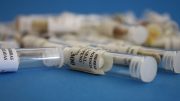Unlike retail pharmacies like Walmart, Walgreens, or Rite Aid, that sell products from pharmaceutical manufacturers, compounding pharmacies produce drugs in case if medication available on the market doesn’t fit the patient’s need.
In compounding pharmacies some substances could be replaced, mixed up, or excluded, if needed. In cases when the active substance is not enough in available solutions, a physician can send an order and a specific drug with the higher amount of the substance will be made for the patient.
Compounding pharmacies, however, are not allowed to make drugs with the same formula as brand-name drugs available on the U.S. pharmaceutical market. Also, drugs which are compounded are not approved by the Food and Drug Administration.
After the 2012 meningitis outbreak, caused by New England Compounding Center (NECC) steroids contamination, authorities of federal regulators were reviewed. But still, federal regulators cannot control all the drugs made in those pharmacies and the quality of each specific drug.
Future Market Insight’s report
According to Future Market Insights (FMI) intelligence and consulting services company, the compounding pharmacies market is growing. In FMI’s report “Compounding Pharmacies Market: U.S. Industry Assessment and Forecast; 2015–2021” company prognoses the market to expand at the Compound Annual Growth Rate (CAGR) of 5.7% during the period of 2015 to 2021.
FMI’s report goal was to analyze the market of compounding pharmacies in terms of market value. In the report, it analyzed market value of the product, value chain, competitions among pharmacies, trends, therapeutic area, and forecast.
By the end of 2015, the estimated account market value of compounding pharmacies was about $3.26 billion. In the report, FMI is projected to see the stable demand for compounded drugs from customers.
Compounding pharmacies got their advantage on the market because of the drug shortages that became common on the pharmaceutical market of the U.S. Drugs shortages are the main force which helps compounding pharmacies to grow quickly and have the constant demand for their products.
There are more than 300 drugs in the shortages list as for now. When the most important drugs are not available on the market, and healthcare facilities are not able to continue their patients’ treatment, compound pharmacies are allowed to produce the substitutes to mitigate the shortage of branded name drugs.
Another cause of increasing demand for compounding pharmacies services is anti-aging compounded drugs. Those drugs are becoming more popular around the world.
On the top of that, a lot of hormone drugs could also be produced in compounding pharmacies for a significantly lower cost, like it was in case of the Makena preterm birth drug.
Compounding pharmacies segmentation in the report
By product
In the report, the compounding pharmacies market has different segments, depending on the product produced. There are four different segments, depending on the product:
- Topical medications segment
- Segment of suppositories
- Mouth washes
- Oral medications
With the FDA safety regulations after the NECC incident, the popularity of non-sterile products continues to grow. As the safety guidelines are improved, the use of compounding pharmacies is growing.
In the period from 2015 to 2021, the growth of oral medications compounding rate will increase by 4.7-8.4%.
Because of formulation rigidity, suppositories and mouthwashes growth rate is lower than the growth rate of oral medications, and topical medications, according to MFI’s report.
Topical medications are the category of pharmaceutical products for skin-application. Topical medications are used where oral dosages could not be effective or will not work, for minimizing patient’s scars, or skin irritations, as well as other dermatological concerns.
With the higher demand for personalization, the easiest producing process among the produces, this category of products will be the second after the oral medication in its growth.
Compounding pharmacies can save significant amount of money for patient because of cheap drugs production regardless of the amount of compounds needed.
By therapeutic area
There are two segments in therapeutic area of compounding pharmacies:
- Pain management
- Hormone replacement therapy
As individual health products and age-defying therapies related to hormone replacement therapy (HRT) are coming more popular, the rate of HRT awareness and popularity will increase as well.
Compared to the other segments of therapeutic area, HRT will show a higher CAGR, according to the company’s forecast.
By application
Four segments were chosen by FMI for analysis the compounding pharmacy market on application basis:
- Medications for veterinary
- Medications for children
- Medications for adult population
- Medications for geriatric population (older people)
During the period from 2015 to 2021, medications for adults may have the higher index of attractiveness, compared to medications for veterinary, children, and older people.
With compounding pharmacies popularity increasing, more adult people are going to use customized medications for their own, personal need. Drugs for critical illnesses like cancer, heart attacks, and strokes are among the drugs for adults.
Additional information
The following market participants were covered in the Future Market Insights report: Cantrell Drug Company, Triangle Compounding Pharmacies, PharMEDium Services, LLC, Institutional Pharmacy Solutions.
You can use the following links for requesting the sample of the report, or sending an enquiry to Future Market Insights.





Be the first to comment on "Compound Pharmacies Market Expand"